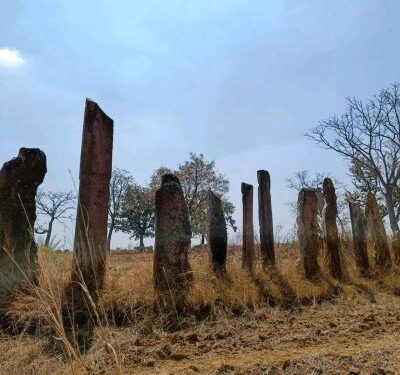
- India has the second-largest tribal population in the world. As per the Census 2011, the tribal population constitutes about 8.9% of the total population in India. The tribal people throughout the country have rich traditions, cultures and heritage with unique lifestyles and customs
- For the discerning readers of Navjeevan Express, we are onboarding Prof Ramya as Editor, Tribal and Women Affairs: R Arivanantham, Executive Editor, Navjeevan Express
- https://navjeevanexpress.com invites thought-provoking articles from experts to enrich the knowledge of our readers
Gudi, made of wood
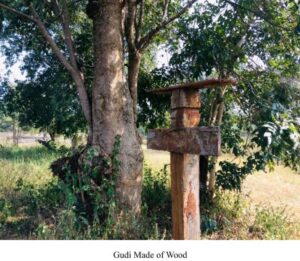
A megalith is a large stone used to construct prehistoric monuments or structures. The word comes from the Ancient Greek words mega (great) and lithos (stone).
Ancient Megalith
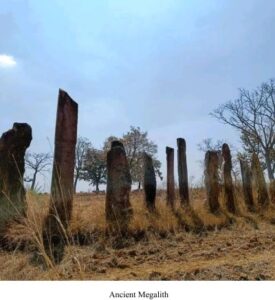
Megaliths were used by ancient communities in Europe, Asia, and Central and South Africa from the Late Neolithic period through the Bronze Age. They were used for a variety of purposes, including as burial sites, for rituals and commemoration.
The tribes of Chhattisgarh have different customs, traditions, costumes, and livelihoods. Gudi, (Memory/Dead Pillars) is one of the significant practices of the Maria, Muria and Gond tribes.
The Pyramids of Egypt draw attention to the whole world which includes the eight wonders of the world. But Bastar also has little fewer wonders.
The custom of making Gudi or Dead Pillars is a tradition among the Maria, Muria and Gond tribes of Bastar and Dantewada in Chhattisgarh.
This megalithic culture has been mainly followed by Maria, Muria and Gond tribes believed to be 3,000-years-old and it started during the agricultural stage of the evolution of humans with stone. Its remains were found in other states like Tamil Nadu, Maharashtra, Assam and even Kashmir.
It’s an ancient belief that even after death, they can embrace the place as a living soul. The memory pillars are erected on the occasion of the death of a person.
Gudi by roadside
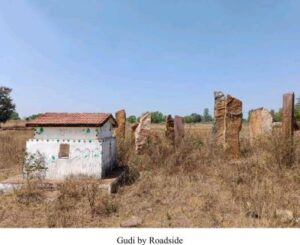
In Bastar and Dantewada districts, it is so common to see pillars either short or tall. Some are made of wood, some stone and yet others with concrete. They are found by the roadside, deep inside jungles or even in the middle of paddy fields.
The pillars are set up ceremoniously on the ninth or tenth day after the death of an individual. Before erecting memory pillars, it is usual to bury coins and utensils underneath as part of an elaborate annual ritual. A feast is also organised and guests are invited.
The oldest ones are of stones and many of them have been declared protected monuments under the Ancient Monuments and Archaeological Sites Remains Act, 1958.
Gudi with hobbies and personal likes
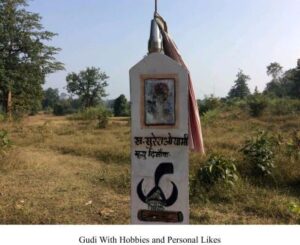
Older memory pillars were painted with animals or scenes from daily life while recent ones bear the name, hobbies, personal likes and dislikes and even photographs of the deceased.
Gudi with musicians and dancers
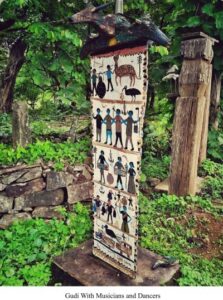
Some of them are no more than upright stone slabs with any engravings/ paintings on them having been defaced by time. Still others have recognisable stone carvings of a fish or a bird perched on top. Those that do still retain the painting show musicians and dancers, animals and plants.
Gudi made of wood
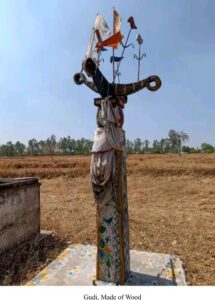
Wooden pillars with carvings still stand, though according to tribal inhabitants, because wood decays and has a short shelf-life outdoors at the mercy of the weather, they prefer using concrete or stone.
Gudi of modern times
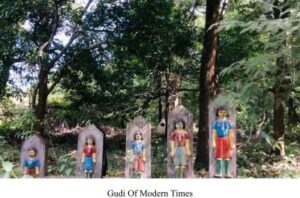
The paintings show the progress of time and some of the newer ones have photographs, aeroplanes, trains, modern buildings and so on. Comfortably sharing space with more traditional tribal motifs. Earlier, natural soil colours were used but now brighter blues, oranges and greens can be seen.
To erect memory pillars, special artisans are hired by families. The artisans stay at the family’s house till the pillar is completed.
Earlier most of them were made of wood but it decays outdoors so people prefer stone or even concrete now.
The cost of the pillars can range from Rs 5,000 to 30,000. Wealthier families may commission larger, brighter, and more expensive pillars. Some families are abandoning the tradition as they cannot afford to make the pillars anymore.
Bearing remarkable beauty, variety and craftsmanship, these pillars erected in honour of the dead dot the landscape of Dantewada as well as the adjoining Bastar district.
These memory pillars are the present-day counterparts of ancient megaliths and show the transformation of tradition over time. Indeed, memory pillars are a continuing megalithic tradition of India.
(Prof Ramya is an Indian Writer and Tribal Researcher, working as an assistant professor in the Department of English at PKR Arts College for Women, Gobichettipalayam, Erode District in Tamil Nadu and presently doing Doctoral Research in Tribal literature. She is researching tribal life and culture in Chhattisgarh, Jharkhand, Kerala, Rajasthan, Madhya Pradesh and beyond. She extends her research area on hidden social issues in India. She focuses on empowering the education and sustainable livelihood of tribes in Tamil Nadu. She has done various research articles on tribes and her works have been featured in Outlook India, New Indian Express, Pioneer, Mathrubhumi, Ground Report and others. She has also written the books titled Voice of India and The Outlook. Her poems have been featured in various reputed magazines like The Literary Mirror, Today Magazine, The Literature Today and beyond.)



